Archive:Internet use statistics - individuals
- Data from November 2013. Most recent data: Further Eurostat information, Main tables and Database. Planned article update: (dd) Month YYYY(, hh:00).
Internet use statistics - individuals
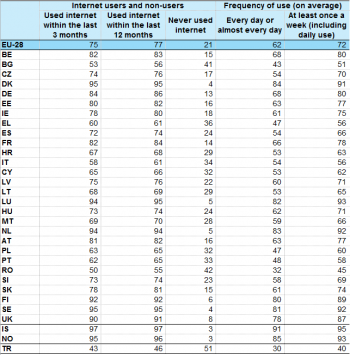
Source: Eurostat (isoc_ci_ifp_iu) and (isoc_bde15cua)
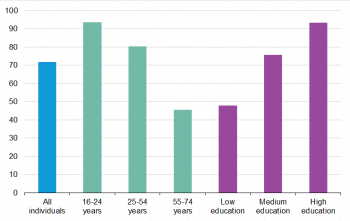
Source: Eurostat (isoc_bdek_di)

Source: Eurostat (isoc_bdek_di)

Source: Eurostat (isoc_bdek_di)
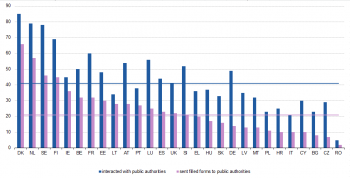
Source: Eurostat (isoc_ciac_i)

Source: Eurostat (isoc_ciegi_ac)
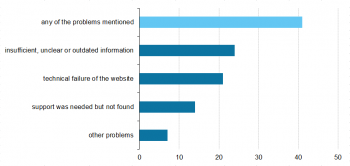
Source: Eurostat (isoc_ciegi_pb)
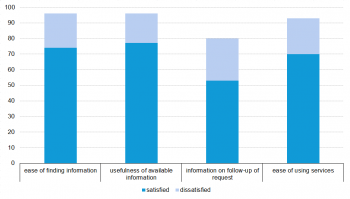
Source: Eurostat (isoc_ciegi_sat)
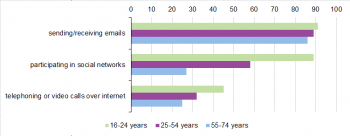
Source: Eurostat (isoc_bde15cua)
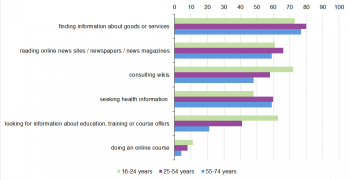
Source: Eurostat (isoc_bde15cua)

Source: Eurostat (isoc_bde15cua)
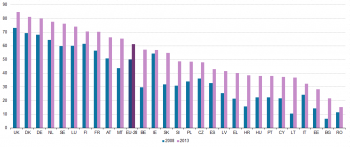
Source: Eurostat (isoc_bde15cbc)
Main statistical findings
A large majority of Europeans make use of the internet. It has become important for daily life, education, work and participation in society and allows to access information and services at any time and any place. As to online access to public services in 2013, two in five individuals (aged 16-74 years) in the EU-28 have contacted or interacted with public authorities or public services via websites for private purposes. A majority of internet users search for information and news, consult wikis, participate in social networks and buy products online. There are significant differences in internet usage between countries and socio-economic groups. About one fifth of the EU-28 population have never used the internet.
This publication provides an overview of the latest results from the 2013 Survey on ICT (information and communication technology) usage in households and by individuals. It takes a closer look at the activities carried out by internet users and at a set of newly released indicators on interactions with public authorities and public services.
Internet use by individuals
Three quarters of Europeans used the internet in 2013
In 2013, three quarters of individuals (75 %) in the EU-28 used the internet at least once in the last three months prior to the survey. Seven out of ten individuals (72 %) had used the internet regularly (on average at least once a week), either at home, at work or at any other place (table 1). This indicator was included in the set of key performance targets of the Digital Agenda for Europe. The current level of use has been just 3 percentage points below the target of 75 % of the population by 2015. The share of daily users among internet users was high in all Member States, Island and Norway. In the EU-28, 62 % of all individuals used the internet every day or almost every day.
There were significant gaps in usage (‘digital divides’) when looking at age groups and level of formal education (figure 1). The percentage of regular internet users among younger persons aged 16-24 was 94 %, more than twice as much as the share for the age group 55-74 years (46 %). The share was also nearly twice as much for individuals with a high level of education (93 %) compared to those with a low level of education (48 %).
In the EU-28, the proportion of individuals who never used the internet declined from 42 % in 2006 to 21 % in 2013 (figure 2). The decline in the proportion of non-users slowed down in the recent years, from 24 % in 2011 to 22 % in 2012 and 21 % in 2013, still 6 percentage points above the target of 15 % non-users set for 2015 in the Digital Agenda.
Large digital divides remain when looking at the share of the population who never used the internet in different countries (figure 3). The highest shares of the population with no past experiences in internet use at all whether at home, at work or at any other place were registered in Romania (42 %), Bulgaria (41 %) and Greece (36 %), the lowest in Denmark and Sweden (4 %), the Netherlands and Luxembourg (5 %) and Finland (6 %). Another four Member States (Italy, Cyprus, Portugal and Poland) showed proportions of about one third of non-users among the population.
Contacts and interactions with public authorities and public services
The following indicators show the use of e-government services by individuals and provide information on the perceived quality of public authorities' websites and satisfaction with e-government services. They inform about contacts or interactions with websites concerning citizen obligations, rights, official documents, public educational services and public health services.
Two in five individuals used e-government services
In 2013, 41 % of the EU-28 population had contacted or interacted with public authorities and public services for private purposes over the internet, 9 percentage points below the target set in the Digital Agenda.
One in five individuals submitted completed web forms. Denmark (66 %) had the highest proportion of individuals reporting that they submitted completed forms, followed by the Netherlands (57 %), Sweden (46 %), Finland (45 %), Ireland (36 %), Belgium and France (both 32 %). Less than one individual in ten in Bulgaria (8 %), Czech Republic (7 %) and Romania (2 %) submitted forms online. Reasons for such differences include in general different levels in internet take-up and the supply of online public services among countries, needs for submitting forms, security or trust concerns or the presence of e-skills and confidence in using websites for the purpose of submitting forms online (figure 4).
Income tax declaration the most popular e-government service
Looking at the purposes of searching and interacting with e-government websites (figure 5), 44 % of users in the EU-28 reported declaration of income tax, followed by requesting personal documents (passport, ID card or driver’s licence) or certificates of birth, marriage or death (20 %), claims for social security benefits or search in public libraries (both 16 %), enrolment in higher education or university (9 %) and notification of change of address (6 %).
Four in ten e-government users experienced problems
Four in ten e-government users (41 %) in the EU-28 stated that they experienced one or more problems when using websites of public authorities or public services. Nearly one quarter of users (24 %) found the information provided insufficient, unclear or outdated, 21 % faced technical problems with the website and 14 % needed but did not find on-line or off-line support via the website for obtaining the right information and forms, filling in or sending forms (figure 6).
One fifth mainly dissatisfied with services
The above-mentioned findings about problems with the provided information and website can be supported by additional indicators on user satisfaction (figure 7). Around a fifth of e-government users in the EU-28 were mostly dissatisfied when considering the ease of using services on websites of public authorities or public services (23 %), the ease of finding information (22 %) and the usefulness of the available information (19 %). More than one quarter (27 %) was dissatisfied with the information provided on the progress and follow-up of requests. Overall, these findings indicate important possibilities for improving the provision of e-government services and increasing take-up by individuals in the future.
Activities carried out by internet users in different age groups
Communication by e-mail had similar importance for internet users in all age groups (figure 8). Larger differences among the younger and older populations who have used the internet in the first quarter of 2013 were recorded for other communication activities included in the survey such as participation in social networks and telephoning or video calls over the internet. The shares of internet users participating in social networking varied from 89 % for the 16-24 year olds to 27 % for the 55-74 year olds. Participation in social networks and e-mails had equal importance for young internet users. The shares of users making telephone and video calls through internet based applications ranged from 45 % in the age group 16-24 to 25 % in the age group 55-74 years.
The internet has found wide recognition as a source of information and knowledge. More than 70 % of internet users in all age groups in the EU-28 searched for information about goods or services (figure 9). Young internet users very much used the internet for learning purposes. Individuals in the age group 16-24 consulted wikis (72 %), looked for information about education, training or course offers (63 %) and read online news (61 %). One in ten young internet users participated in an online course.
Most internet users in the age group 25-54 read online news (66 %), searched for health information (60 %) and consulted wikis (58 %). These activities were also popular among internet users aged 55-74: nearly 60 % read online news and searched for information about health and about half of them consulted wikis to obtain knowledge on any subject.
While participation in social networking showed rates above 50 % among internet users aged from 16 to 54 years in the EU-28, opinions on civic or political issues via blogs, social networks, e-government and other websites were posted by fewer than one in five individuals (figure 10). In the age group 55-74, one in ten internet users posted such opinions.
A small proportion of the online population was taking part in online consultations or voting to define civic or political issues (e.g. urban planning, signing a petition). One in ten internet users in all three age groups participated in policy decision making processes.
E-shopping trends
Six in ten internet users shopped online
Buying over the internet (e-commerce or e-shopping) has become very popular in the EU. In 2013, 61 % of internet users in the EU-28 bought or ordered goods or services over the internet for private purposes, representing an increase of 11 percentage points compared with 2008. The shares of e-shoppers among internet users varied considerably among Member States. The highest proportions of online shoppers were registered in the United Kingdom (85 %), Denmark (81 %) and Germany (80 %), the lowest in Romania (15 %), Bulgaria (22 %), Estonia (28 %) and Italy (32 %). Between 2008 and 2013, Belgium, Lithuania, Croatia, Slovakia and Malta recorded the highest growth of 20 percentage points and more (figure 11).
Data sources and availability
The findings are based on the survey on ICT usage in households and individuals which is implemented yearly. Data for 2013 were aggregated from microdata transmitted by all EU Member States and other countries (Island, Norway). They are available via the Eurostat website (see link below). Access to microdata for researchers is possible.
The survey covered households with at least one person aged 16-74 and individuals aged 16-74 years. In 2013, 148290 households and 220436 individuals in the EU-28 were surveyed.
Individuals were asked about the last time of internet use, frequency and place of use, mobile use, activities including e-government and e-commerce, and e-skills. In general, internet activities were carried out in the previous three months before the interview. The main reference period was the first quarter of 2013; the data was collected in most countries in the second quarter. Activities such as e-government and e-commerce cover a reference period of the last 12 months prior to the survey because of the irregular and seasonal aspects of use. The 2013 survey included a special module on the use of e-government websites.
‘Digital divide’ is a term used to describe gaps and pattern of access to the use of computers and the internet across the population and countries. The definitions of ‘e-commerce’ and ‘e-government’ exclude manually typed e-mails. In addition, for the purpose of the survey, the term ‘public services’ excluded public postal and public transport services, public utilities (e.g. electricity), public news and weather forecast services.The definition of education levels is: high (tertiary education, ISCED 5 or 6), medium (upper secondary education or post secondary, but not tertiary, ISCED 3 or 4), low (no formal education completed, primary or lower secondary education, ISCED 0, 1 or 2).
Context
The findings are used for monitoring several EU policies, in particular the Digital Agenda for Europe. The Digital Agenda for Europe is one of the elements of the Europe 2020 growth strategy and has included several key performance targets for internet usage and take-up of services. The Digital Agenda Scoreboard reports monitor annual progress on the basis of the indicators included in the 2011-2015 Benchmarking Digital Europe Framework.
The Digital Agenda for Europe includes, among others, measures of promoting eGovernment and exploiting the benefits of ICT in helping the public sector to develop innovative ways of delivering services to citizen with fewer resources. Within this context, a key performance target has been set: By 2015, 50 % of EU citizen should have used eGovernment. The European eGovernment Action Plan 2011-2015 supports the provision of a new generation of eGovernment services at local, regional, national and European levels.
Further Eurostat information
Publications
Database
Dedicated section
Methodology / Metadata
Source data for tables, figures and maps (MS Excel)
Other information
- Regulation (EC) No 808/2004 of 21 April 2004 concerning Community statistics on the information society
- Regulation 960/2008 of 30 September 2008 implementing Regulation 808/2004 concerning Community statistics on the information society
- Regulation 1023/2009 of 29 October 2009 implementing Regulation 808/2004 concerning Community statistics on the information society
- Regulation 821/2010 of 17 September 2010 implementing Regulation 808/2004 concerning Community statistics on the information society
- Regulation 937/2011 of 21 September 2011 implementing Regulation 808/2004 concerning Community statistics on the information society
- Regulation 1083/2012 of 19 November 2012 implementing Regulation 808/2004 concerning Community statistics on the information society
External links
See also
Notes
[[Category:<Information society>|Internet use statistics – households and individuals]] [[Category:<Statistical article>|Internet use statistics – households and individuals]]